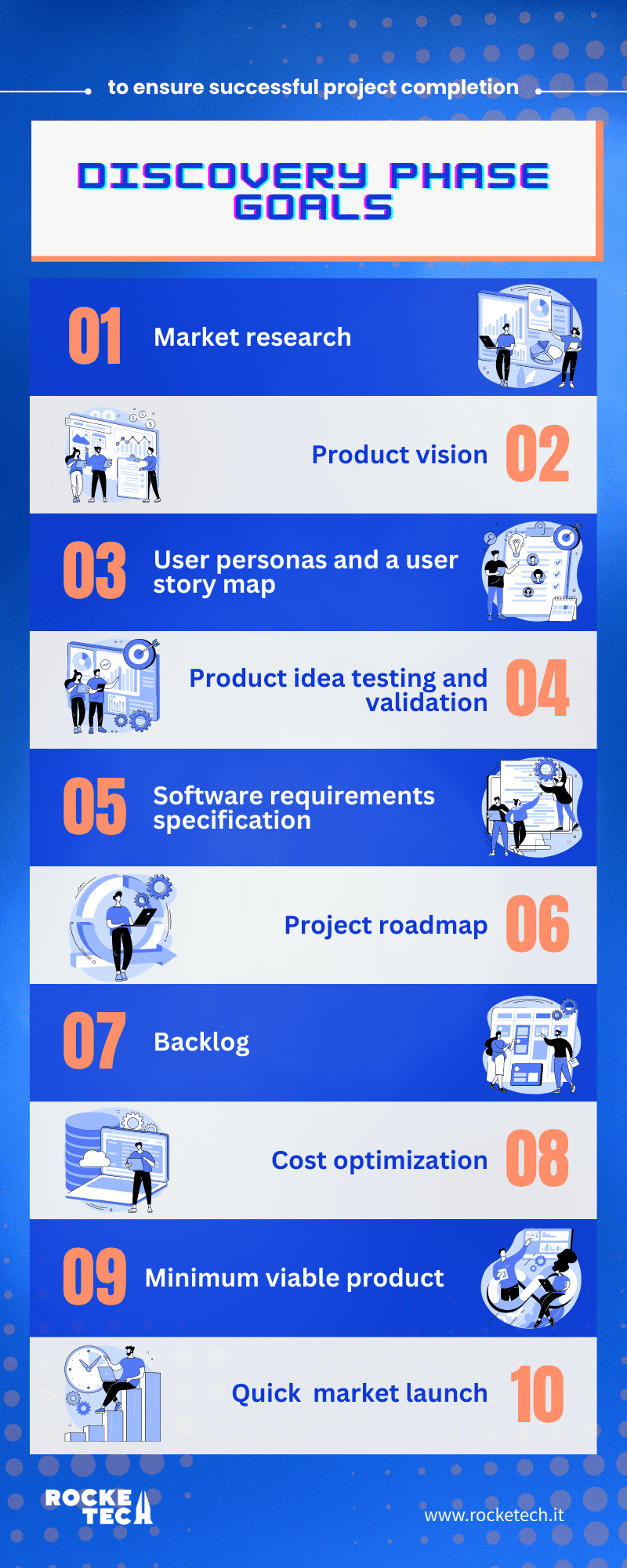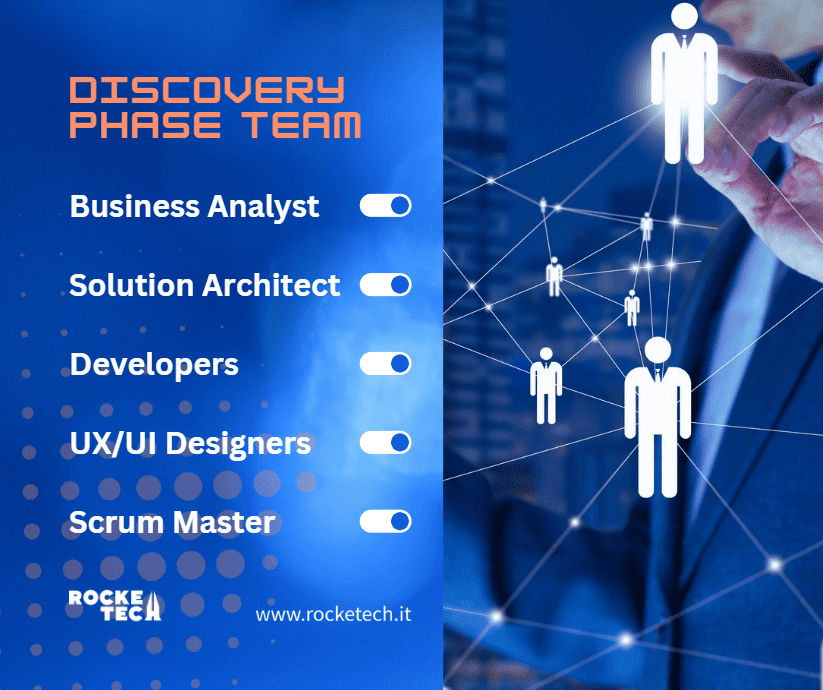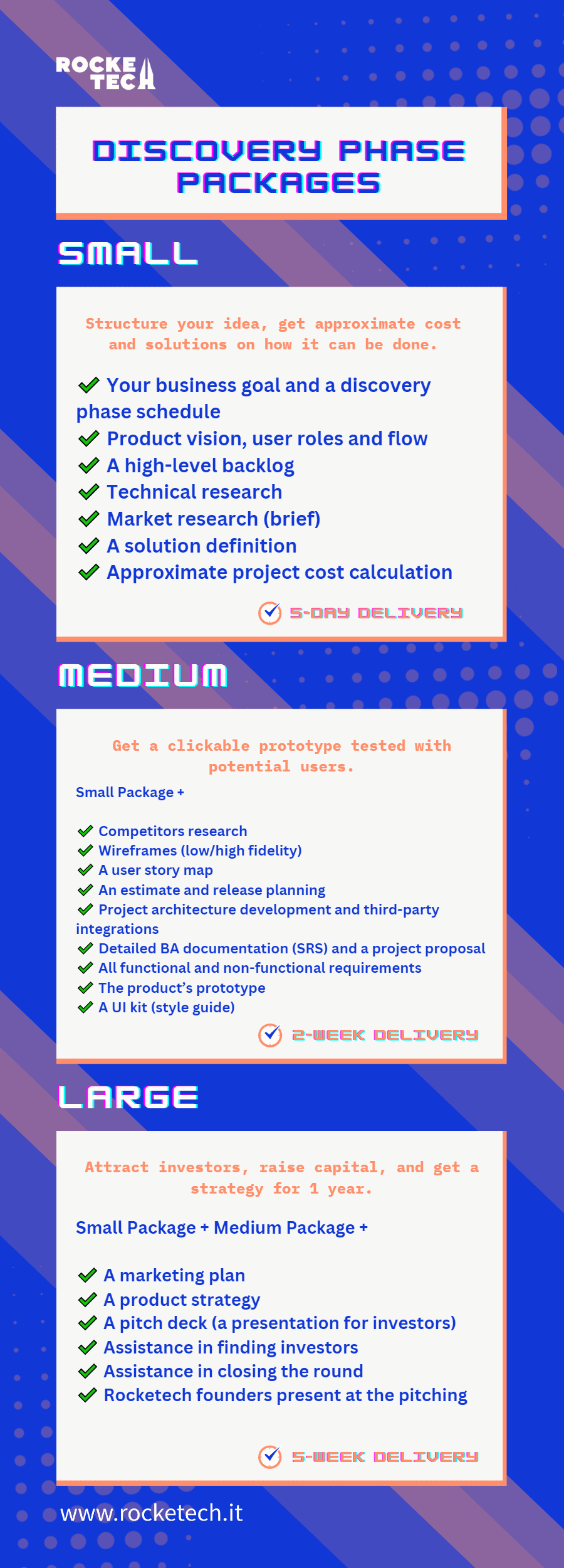Launching a product-based startup is overwhelming, and many aspiring entrepreneurs end up losing focus and burying seemingly brilliant ideas. The discovery phase (especially in the agile approach to software development) can help you stay on track, define your business goals, and find ways to achieve them.
Clients often approach custom software development companies with minimum information about what they want and why. The discovery phase helps both sides understand what the business actually needs and how different the real goals are from the client’s desires. Here’s what you need to know about the project kick-off and how to get maximum value from it.

What is a Discovery Phase, and Why Do You Need It?
Most Internet sources will explain the discovery phase definition as a “process of information gathering.” Although technically, it’s not wrong, an effective project initiation implies much more than just listening to the client’s wishes and desires and looking up what potential competitors are doing.
The discovery phase in software development is a preliminary stage helping a project team understand the software project’s scope, requirements, goals, and objectives. The discovery phase’s purpose is to establish a shared understanding between the development team and the stakeholders (e.g., the business, end-users, or customers). Ideally, everyone involved should know what the project will entail and deliver and how to meet the needs of all parties.
The discovery phase is the first crucial development stage designed to set business goals and draw a roadmap toward achieving them. It’s aimed at defining the product, analyzing the market, and learning what the target audience needs. As a result, it helps all stakeholders understand each other’s expectations and establish efficient cooperation.
So, what is a project discovery? In real-life projects, this stage goes beyond simply discussing ideas and writing a technical specification. It helps the client and the service provider to:
- Clarify project objectives: It helps identify and formulate project objectives to ensure that the software project will bring the desired results.
- Reduce project risks: By thoroughly defining the project requirements and scope during the discovery, businesses can reduce the risk of misunderstandings during the development phase. Miscommunication always leads to financial losses.
- Improve project efficiency: It helps predict potential technical challenges and obstacles early on, allowing the project team to plan and prepare accordingly, improving project efficiency.
In other words, every piece of information collected during the discovery stage helps the tech vendor determine the scope of work and time frames and plan the project tasks. It has one big ultimate goal — to create a quality software product designed for the client’s needs.
Project Discovery: What Is Included?
While the initial activities are about planning, the first stage itself must be well-planned. The discovery phase steps typically cover the main aspects of project management, from ideation to the implementation roadmap.

The Discovery Phase of a Software Development Project: Who Is Involved?
Naturally, discovery teams may vary depending on the project’s size and complexity and the client’s specific needs. However, based on our experience, the following specialists make up the best combination.
Business Analyst
A business analyst gathers and analyzes market- and product-related data and makes recommendations to decision-makers. Use cases, user stories, reports, and business processes are right up their alley. BAs bridge the gap between technical and non-technical stakeholders and ensure that the project’s tech sides align with the client’s business goals.
For example, the client needs an online booking system integrated into the product. If the vendor starts with technical questions about the functionality, they may miss some crucial requirements. Why does the client need it? What does it solve? Here, the BA’s task is to listen carefully, build logical connections, and clarify controversies.
Solution Architect
A solution architect is an experienced specialist who sets goals and objectives for the project execution, finds the best technical solutions, describes the software’s structure and behavior, and distributes functions between developers. They also consider cost, scalability, and compatibility with existing systems while making decisions.
Developers
Software developers with diverse expertise help the discovery team make more precise estimations. Professionals who have participated in several similar projects (comparable functionality, the same frameworks, domains, product types, etc.) evaluate the project’s potential based on their hands-on experience.
UX/UI Designers
User experience and user interface specialists can create wireframes and clickable prototypes if those are part of the discovery. Their main task is to show what the future application will look like. However, they also help the team assess the project’s complexity.
For a B2C product targeting mainstream users, UX designers would be an essential part of the discovery team — user experience is crucial for such solutions. Now let’s take entirely technical projects focusing on professionals in a particular niche. Here, UX plays a secondary role, while purely technical requirements become the first priority. The discovery phases for these examples will be different.
Scrum Master
The formula Business Analyst+Scrum Master proves to be more efficient than a single Project Manager who, in the end, takes on too many tasks and often loses focus. While the BA connects business and development, the Scrum Master is responsible for efficiency, transparency, timing, and evaluation.

The Main Benefits of a Discovery Phase
Successful project management and discovery must bring tangible advantages to all stakeholders. For example, businesses can predict risks and minimize financial losses in the long run. Here’s the list of the key benefits of a discovery phase:
- A better understanding of project requirements;
- Defined project scope and evaluated project complexity;
- Detailed and simplified budgeting and planning;
- Project estimations based on the team’s hands-on experience;
- Improved team efficiency;
- Enhanced project alignment and agreement;
- Improved communication and collaboration between all stakeholders;
- Reduced and mitigated risks (first of all, financial);
- The balance between business objectives and the market need;
- A clear technical description;
- Visualized product vision.
The main advantage of any discovery phase is a detailed action plan created by people who will follow it. By taking the time to plan and communicate effectively, you and your tech contractor turn an abstract idea into a real roadmap based on your business needs, market conditions, and budget.
We can provide support and expertise.
What Will Happen if You Skip the Discovery Phase Activities?
In a nutshell, make a list of the things that can go wrong and imagine that most of them did go wrong. Lack of planning — and efficient planning is the purpose of any discovery phase — always has significant consequences. We’ve summed up the most common of them.
Misaligned Expectations
Without a discovery phase, you may end up having a conflict of “three products”: what you expected, what the development team created, and what your target audience is ready to pay for. Most often, they are completely different.
Scope Creep
Without a clearly defined plan, projects easily grow beyond the original objectives and goals. It leads to missed deadlines, increased costs, and often even wasted budgets.
Related article: How to Avoid Common Project Estimation Mistakes
Technical Issues
The discovery phase helps you identify and address technical challenges and limitations before development starts. For example, different programming languages, libraries, or APIs are not fully compatible with each other. It requires finding alternative solutions or making changes to the code. Experienced developers will consider such issues and the time to solve them before encountering them.
Increased Project Risks
Unexpected technical difficulties, lack of resources, changes in requirements, or miscommunication between team members lead to delays in delivery. In turn, every delay leads to increased costs and frustration among the stakeholders. Risk mitigation is one of the discovery phase’s main purposes.
Unclear Budget and Time Frames
Imagine your development team increasing the bill after every iteration, while you are still not seeing the results. It’s a likely scenario in terms of budget and deadlines if you skip the discovery phase. The developers don’t have a well-articulated goal and can’t keep track of smaller objectives while the time is running out.
A Product Nobody Needs
9 out of 10 startups fail. Most of them fail because the founders think they know what their target audience needs and wants. In reality, they don’t. The discovery phase is an instrument devised to find product-market fit through customer development activities like problem and solution interviews and working directly with real customers’ feedback.
The Discovery Phase Deliverables
Many startup founders are skeptical about the discovery phase as it may seem like an abstract discussion of possible ways of doing things. However, by the end of this stage, your tech vendor must provide you with actual and well-documented results. It’s a ready action plan.
The discovery phase’s main outputs typically include:
- A clear and agreed-upon project scope that outlines the project goals and objectives, requirements, and constraints.
- A detailed project plan that outlines the timeline, budget, and resources required to complete the project.
- A high-level solution design that defines the architecture and technical approach to the project.
- Alignment and approval between the stakeholders, business, and development team on the project goals, requirements, and solution design.
- Identification and mitigation of potential project risks and challenges and the ways of solving them.
- Improved communication and collaboration between the stakeholders, business, and development team ensuring the project is executed smoothly and efficiently.
| Our most experienced specialists designed the three Discovery Phase Packages covering all project initiation aspects and devised for different budgets and levels of involvement. |

The Discovery Phase with Rocketech
At Rocketech, we start every project with a discovery sprint — a workshop with a seasoned business analyst experienced in the customer’s industry or niche. The BA gathers business requirements and helps the client prioritize tasks based on business goals and vision, build a development team, and make initial development investments as clear and relevant as possible. A discovery phase project plan with Rocketech is a thought-through roadmap to launching a successful marketable digital product.